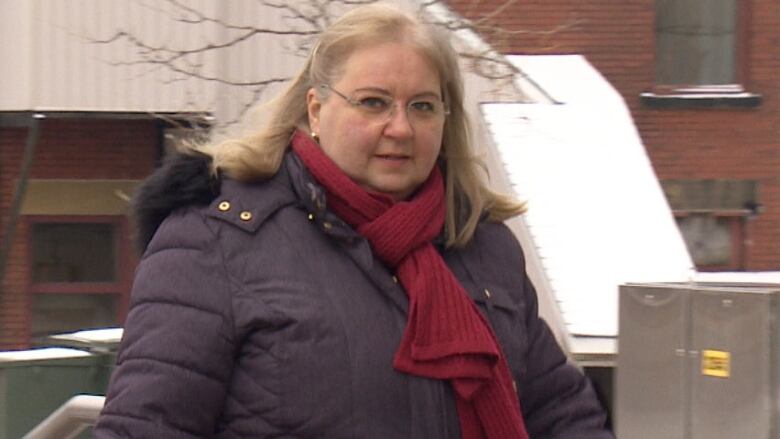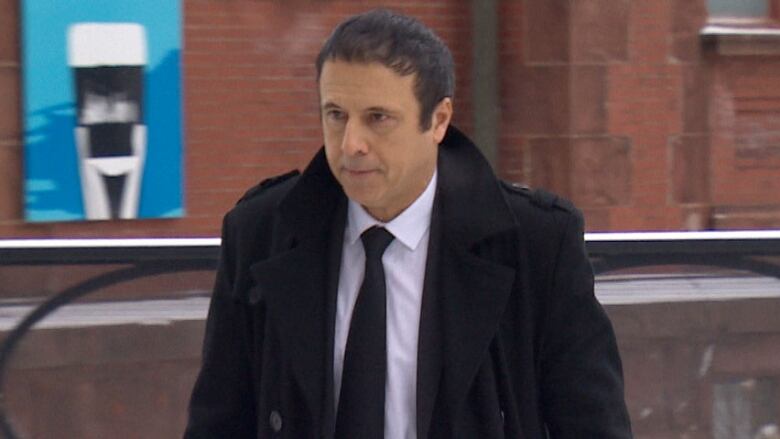Dennis Oland's defence misunderstood cellphone evidence at first trial, retrial hears
Victim's missing iPhone focus of testimony Thursday

Dennis Oland's defence team misunderstood some of the cellphone-related evidence at his firsttrial in 2015, his murder retrial in the 2011 bludgeoning death of his father heard on Thursday.
"We now understand 'roaming error' correctly," lead defence lawyer Alan Gold told the Saint John Court of Queen's Bench.
"We were misinformedat the first trial."
The term "roaming error" is related to attempts by the Rogers Communications law enforcement support unit to locatethe victim's iPhone,which went missing the day he was killed and has never been recovered.
When a cellphone is on, it emits periodic signals to communicate with the networkso that when calls are made and received, the network has a general idea of the phone's location for service delivery.
Rogers, at the request of police,can initiate a signal, known asa "forced registration," to try to obtain the GPS co-ordinates of a particular cellphone.
The communications company tried to "ping" the victim's iPhoneat the request of the Saint John Police Force, but got a "roaming error" message, Sylvie Gill, an investigator with the specialized unit testified.
Positions reversed
When that search was performed was the focus ofmuch of the testimony Thursday and it appears the Crown and defence have reversed positions from the first trial.
The defence now contends it was on July 7, 2011, the day the victim'sbody was discovered, while the Crownnow says it was on July 9, 2011.
The relevance of the issue in the case against Olandhas not yet been made clear, but Crown prosecutor Derek Weaver did tell Justice Terrence Morrisonthat a "missing piece of the puzzle" isan agreed-todefinition of "roaming error."
"And through that, whether the roaming error was on July 7, 2011 or July 9, 2011 does play a factor in this."

Gold also revealedthe defence has been meeting with an engineer in Montreal, "who may well be a witness."
The parties are expected to square off on the issue again when the retrial resumes on Friday,after an unusual application by the defence was set over to give the Crown an opportunity to consider its position.
The defence is seeking to have an officer'stestimony about what he says a Rogers employee told him over the phone regarding the roaming error normally considered hearsay evidence accepted as fact.
Oland, 50, is being retried for second-degree murder afterthe Court of Appeal overturned his 2015 conviction and ordered a new trial, citing an error in the trial judge's instructions to the jury.
He is the last person known to have seen his father alive when he visited him at his office onJuly 6, 2011, between around 5:35 p.m. and 6:30 p.m.

The body of the 69-year-old multimillionaire was found in the office the next morning, face down in a pool of blood. He had suffered45 sharp- and blunt-force injuries to his head, neck and hands.
HisiPhonewas the only item missing from the crime scene, the Crown has said, while other valuable items, such as his Rolex watch, cash and electronic equipment were left untouched.
Earlier in the trial, Acting Insp. David Brookerof the major crime unittestified that on July 7, 2011, at 4:30 p.m., just hours after the victim's body was discovered, he called Rogers Communications about trying to locate the iPhone.
Brooker said he was told Rogerscould not locate thecellphone, although he couldn't recall the technical term used by the employee he spoke to.
During cross-examination, Gold suggested it was "roaming error." Brooker agreed.
"And you got that information on July 7?" Gold had asked.
"Yes," the officer replied.
Defence objects to its own former exhibit
The Crown contends Brooker is mistaken about the date; that Rogersactuallyperformed the forced registration two days later.
On Thursday, while questioning Gill, Crown prosecutor Derek Weavertried to enter into evidence a document that indicated Rogers performedthree pings on July 9, 2011 and they all came back as roaming errors.
Interestingly, the documenthad been a defence exhibit atOland'sfirst trial,when, as Weaver put it, the defence had "vehemently" arguedthe roaming errorsoccurred on July 9.
Gold objected to any reference to the first trial andobjected to the document being submitted. He argued itwas not an official Rogers report, but rather a "cut and paste" from anemailGill was not a party to and therefore could not authenticate.
But there is no official report on the contentious issue, the courtroom heard. Rogersonly keeps logs of any such searches for up to two years.
"Our concern, obviously, is this court will be left with the impression that there may have been a roaming error on July 7," said Weaver.
The judge sided with the defence and refused to accept the document, but did say the Crown can try to submit itlater, through another witness.

The missing iPhone had been functioning on July 6, 2011, Rogers'call detail records for the victim showed. The admissibility of those records had been challenged by the defence during a pre-trial hearing, but the judge had ruled them admissible.
Gill went over the spreadsheet line by line, showingthe dates and times of all the calls and text messages, the incoming and outgoing numbers, the duration of the calls and voicemail messages, and which cell towers the phone connected with.
The phone connected with a cell tower in Rothesayin the morning,when the victim was at home, and then switched to a cell towerin uptown Saint John near his office whilehe was at work, according to the records.
At 6:44 p.m., Gill said the phone switched back to a cell towerin Rothesay, located near the Renforth wharf where the accused had told police he stopped on his way home from visiting his father that night.
All incoming calls after that time went directlyto voicemail, said Gill, and text messages were "not delivered to the device."

Earlier in the day, the court heard the iPhonehad been connected to the victim's computer during the afternoon and a backup was created.
PaymanHakimian, a computer forensics expertwith theRCMP'stechnological crimes unit in Fredericton, testified the phone was connected at 1:50 p.m., backed up by 4:41 p.m. and disconnected at 4:44 p.m.
Saint John police were scouring the backup datafor any evidence related to the homicide as recently as a few months ago, the retrial heard. Hakimianproduced a"data dump" of theiPhonebackup in August 2018.
A colleague had produced a similar data dump in 2012, but Hakimian usedthe latest technologyavailable. It produced 1,260 pages of raw data, according to Gold.
Hakimian said he didn't know how long the report was because it was in electronic form but agreed with Gold itwould have included all call logs and text messages everything that was on the cellphone at the time the backup was created.
- On mobile?Get the latest details from our liveblog
Hakimianalso produced a data dump in 2011 of the three computers seized from Oland's home a week after his father's bodywas discovered. He used a special forensic tool that would also extract any deleted data, he said.
"And again, you were providing the raw data to see if the Saint John police force could possibly mine it for something useful in connectionwith this case?" asked Gold.
"That is correct,"Hakimianreplied.
Nothing incriminating was found.
"We unfortunately don't know why theiPhone4 was taken," Crown prosecutor Jill Knee had said during opening remarks. "We never will."












_(720p).jpg)


 OFFICIAL HD MUSIC VIDEO.jpg)
.jpg)



























































































